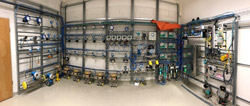
Posted to News on 21st May 2020, 17:08
APL used successfully in test setup at BASF
For many years users in the process industry have pondered how Ethernet should be implemented in potentially explosive atmospheres. With the successful testing of the APL solution by BASF, significant progress has been made.

Ethernet for the process industry? Absolutely! "We want more bandwidth and speed all the way to the field level," emphasised Gerd Niedermayer of BASF in light of a workshop at the most recent Namur annual general meeting (November 2019). After all, device communication at the field level is undergoing a transformation with an increase in complexity. Ethernet solutions in the process industry were not so easy to come by in the past, though. Sticking points included intrinsic safety, cable lengths of up to one kilometre and cost-effectiveness. After all, there are still limitations given the large number of explosion-protected systems in the chemical industry, where standard solutions had simply been inadequate in the past. This is why work was carried out intensively on a two-wire Ethernet solution for process automation under the umbrella of PI (Profibus & Profinet International) over the past few years.
The concept was introduced as the Advanced Physical Layer (APL) two years ago and is based on IEEE and IEC standards. With this, Ethernet technology is thus being advanced all the way to the field level in the process industry. The concept has held up, but has this solution passed the test in practice as well?
APL in a test setup
This question was addressed in March 2019 at the BASF site in Ludwigshafen, Germany, where the chemical company created a test setup (see photo, copyright BASF). When the test scenario was devised, standard BASF requirements for new systems were used for orientation. These requirements are indeed drafted quickly but are complex in their implementation. High-performance digital communication all the way to the field level is therefore expected for the overall system. A single Ethernet protocol for all process components - sensors, actuators, motor control units, frequency converters, etc - is desired. "Ethernet communication all the way to the field level not only needs to be very robust, but it also has to be very highly available," said Niedermayer in describing the requirements. In addition to this, high-performance parallel data exporting from the field devices for Industry 4.0 applications was also desired.
Profinet was used in the test system, as was APL in order to clarify use in potentially explosive atmospheres. There was no shortage when it came time to choosing devices - sensors from Endress+Hauser, Vega, Krohne, Samson, Brkert, Emerson and Festo were used in the test application, as were components from Phoenix Contact, Danfoss, Indusol, Natus, Siemens, ABB, Emerson, Honeywell, and Pepperl & Fuchs. The devices were still prototypes in fact, as no devices featuring the APL were available as standard when the project began. It is just a matter of time, though, as the first series-production devices are planned for 2021.
Focus on practicality
Test results were presented at the Namur meeting, and the test application was executed with full redundancy - both a field system and a control room area were presented. Two Profinet controllers were used for each ring, which corresponds to a field with 250 field devices. According to Niedermayer, "The focus of the test setup was on integrating all field device types and actuators into the control system." Practical aspects like the installation and connection of all components, the supply of power and Ethernet communication over the fieldbus cable to the field device and configuration of the I/O level and visualisation were of primary importance here. This was followed by questions regarding how IP addressing works and how names are issued.
Communication in mixed operation is also especially interesting for process industry plants. For example, are there problems if APL field devices and Profibus PA field devices are connected to the same switch, or can different Profinet nodes - ie APL switches, proxies, remote I/Os, etc - from different manufacturers communicate with one another in a ring? Is device replacement possible via neighbourhood detection, like the Link Layer Discovery Protocol, and are new field devices configured automatically?
Positive test experiences
Due to the sensitivity of systems in hazardous areas, it was important to play it safe before using the technology in real-world systems. Under the critical eye of Niedermayer, the team tested the system structure with many different variants and was positively surprised. Summing up the results, Niedermayer said, "For all intents and purposes, everything worked. It was easy to integrate and connect the devices to the control system using GSDML files," said Niedermayer in naming one example. The field devices were attached to the APL switches via terminal connections here, and the APL field devices were connected with reverse-polarity protection. Operation over the fieldbus cable was stable, and configuration of the field devices was fast and easy. This was also the case with Profinet-based plug-and-play device replacement. The replacement device was automatically detected by the system and loaded with the corresponding configuration. The device was available again in less than one minute. The tested redundancy mechanisms - if supported by the node - took effect at a specified time (200ms or less). The team also tested different variants in mixed operation. Regarding the results, Niedermayer said, "There were no communication problems between the different nodes. All the prototypes worked."
Reducing complexity
The results of Namur Working Group 2.6 (Digital Process Communication) were clear: initial practical-use testing of the Ethernet APL was a success. "The results of the test are encouraging, and we hope communication solutions will be less complex thanks to the APL," remarked Oliver Weigel of Namur Working Group 2.6. "Now we can finally develop migration strategies with the APL as well" - after all, existing fieldbus lines can indeed be used.






























